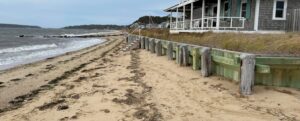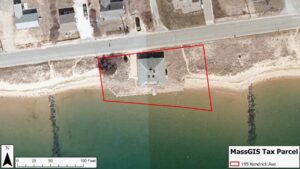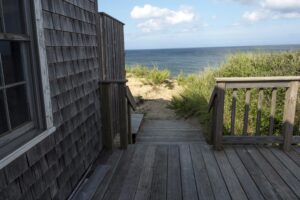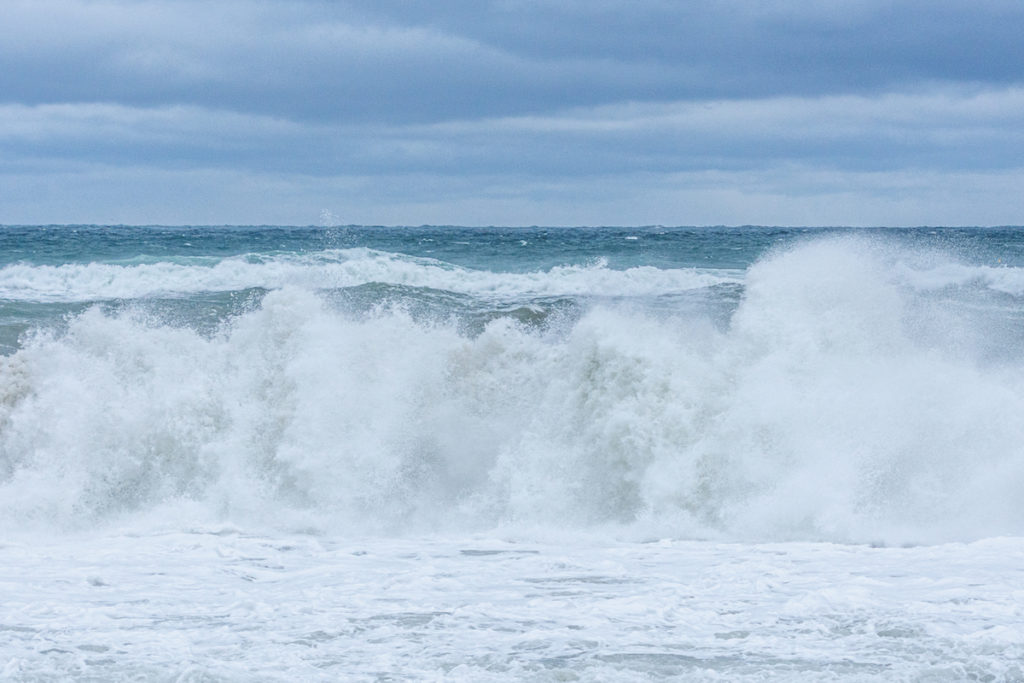WELLFLEET — Seawalls and bulkheads built to fend off coastal flooding are becoming a thing of the past here and in communities all along the Massachusetts coast. They are, with few exceptions, no longer permitted, but because maintenance of existing structures is allowed, local conservation commissions continue to consider the legality and potential effects of such projects on a case-by-case basis.

The complexities of the process — and the increasing threat climate change poses to shoreline properties — came into view at an Oct. 16 hearing before Wellfleet’s conservation commission that was followed by a study completed in mid-December, with the hearing to be continued on Jan. 15.
In this case, the proposal seeks to shore up a decades-old wooden bulkhead at a house on Mayo Beach. The seawall is regularly washed over during severe storms. The 1930s hip-roofed bungalow is owned by John Hall of Natick, who purchased the shoreline property at 195 Kendrick Ave. in 2019.
Hall knew he would be required to do some bulkhead maintenance and erosion control when he bought the house, including dumping sand as beach nourishment annually. He didn’t expect that in just five years the threat of flooding would force him to up his game.
His property has flooded three times since he bought it, and the water has run across Kendrick Avenue and damaged some of the mobile home condominiums at Harborside Village. Hall wants the conservation commission’s approval to add 30 inches to the height of the existing wooden bulkhead, which spans the front of his property and curves toward the road on both ends. Hall initially hoped he could extend those “wings” to protect the land eroding on either side of his house. On the west side, loss of sand is threatening his septic system and leaching field.
“With climate change, I’ve lost 10 feet on both sides of my property,” Hall told the conservation commission.
Beaches Versus Seawalls
When it comes to building barriers to protect coastal properties from surging tides during our increasingly frequent storms, the choice is between beach and seawall, according to Mark Borrelli, a coastal geologist at the Center for Coastal Studies in Provincetown. “If you want a seawall, the beach goes away,” Borrelli told the Independent in a Jan. 3 interview.

Vertical structures like seawalls and bulkheads may protect the properties directly behind them, but they reflect waves sharply, increasing their energy, stirring up sediment, and scouring away beach sand at the base of the structures.
Where there is a seawall, eventually the property will have no beach at high tide and ultimately there will be no beach at low tide, according to Borrelli. Meanwhile, he added, storm water will create pathways on areas adjacent to the seawall.
Protecting Neighbors and Shellfish
Hall’s Kendrick Avenue house lies within several areas regulated by state and local wetlands laws, including land subject to coastal storm flooding and a coastal dune and beach. It is also in a Federal Emergency Management Agency (FEMA) velocity zone for wave action.

Hall’s house was built in 1930, so he has assumed the bulkhead was installed before the 1978 passage of the Wetlands Protection Act.
Seawalls, bulkheads, and revetments, known as coastal erosion structures (CES), that were built before 1978 are grandfathered under state wetlands protection laws that went into effect that year. Owners can restore and maintain the existing structures, but new structures are allowed in Massachusetts only “in very limited circumstances,” according to a publication by the Mass. Office of Coastal Zone Management.
Borrelli said he could not recall the permitting of a new bulkhead or seawall other than one in Eastham. That one was allowed because all adjacent properties had seawalls, and they ended up channeling water onto the one property without a wall.
During the Oct. 16 hearing, the conservation commissioners were critical of Hall’s proposal, which was presented by Joseph Hannon of Atlantic Coast Engineering.
Commissioner John Cumbler focused on the proposed wing extensions. The one to the west of the house was going to run almost to the edge of Kendrick Avenue, he said. “The way I see it is that wave action will lead to more erosion that will threaten the houses across the street rather than protect them,” Cumbler said.
Neighbors, like those in Harborside Village who submitted letters of support for Hall’s proposal, probably did not understand the hydrology of the area, said commissioner Barbara Brennessel.
Conservation agent Lecia McKenna said state wetlands laws are clear about adding structures on a coastal dune. “You have to meet performance standards for the dune, and this project doesn’t meet standards,” she said. New structures like seawalls and bulkheads are not exempt from the state requirements.
For that reason, the proposed wings to the bulkhead would not be allowed.
McKenna said there have been instances when requests to increase the height of a bulkhead were approved, but the applicant would have to prove that doing so wouldn’t adversely affect the neighbors. “It will exponentially increase the wave action there,” she said.
McKenna also reported that DPW Director Jay Norton was concerned that a raised bulkhead and wings could affect visibility for motorists on Kendrick Avenue.
If the height of the bulkhead is increased, Hall will be required to provide even more sand annually for beach nourishment. Hall had complained that supplying the sand each year was costly, and a single storm can wash it all away.
That erosion is detrimental to nearby shellfishing beds, according to a letter Shellfish Constable Nancy Civetta sent to the conservation commission before its October hearing. Shellfish farmers have, she wrote, “expressed significant concerns over the past decade that sand from beach nourishment activities migrates to their site, covering their product and gear in deep sand, which compromises their product, including causing mortality.”
Reducing the volume of sand for beach nourishment would allow for healthier shellfish beds, Civetta said in her letter.
Preparing for the Worst
Raising the house would provide the best protection from flooding, which is what Hall plans to eventually do, said Hannon. That won’t happen for a while, said Hall. Because of the age of the house, he said, “It is more than just raising. It would take a lot of structural work.”
The conservation commission continued the hearing to allow time for an independent study to be done by Bryan McCormack, the coastal processes and hazards specialist for the county. The study was completed in mid-December. McCormack concluded that the bulkhead, even with 30 inches added, would not stop flooding in a 100-year storm. The higher bulkhead would also accelerate erosion at its base, he found.
At the commission’s Oct. 16 hearing, Hannon conceded the increased height of the bulkhead would not protect the house in a 100-year flood but said it should decrease the number of times that waves crest over the bulkhead.
The conservation commission directed Hannon to produce a new plan with changes such as removal of the wing extensions, to provide proof that the project had secured a required Chapter 91 license, and to delineate the height of the bulkhead with the proposed increase.
Borrelli said buyers, in at least some cases, may have never lived on the coast and are unaware of responsibilities connected to coastal properties. In North Carolina, about which Borelli has read other research on seawalls, prospective buyers of coastal properties are told what to expect when they purchase a coastal property, he said.
“It would be nice to have the same policy of telling people here,” Borrelli said. “People here have no idea of what’s going on at the coast.”



